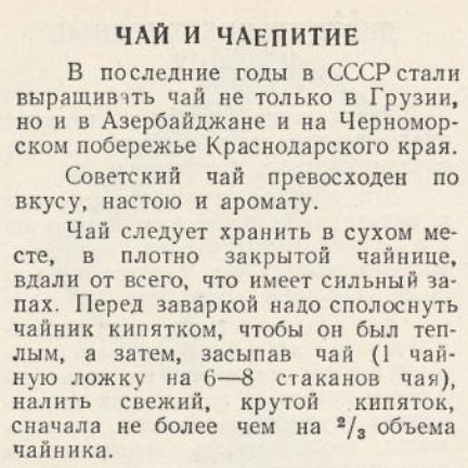
Tea "vprikusku". Source: Anna Kharzeeva
Anna KharzeevaThis piece is part of the Soviet Diet Cookbook, a blog about a modern Russian girl cooking Soviet food. To read more of the series, click here.
Why do you need to have so many weird teas? Isn’t black enough?” asked my Australian friend, trying to figure out Russia’s obsession with tea.
We love our tea in
Today there is indeed a huge variety of tea available in restaurants,
We (or at least I) love it because it can keep you warm through the cold times, provide excellent procrastination opportunities and a great way to socialize and eat candy.
When I was a kid, tea options were much more limited. It was all black, although herbs and berries would still be added when available. Black tea was (and still is) drunk with lemon and sugar — either dissolved in the cup or “
The recipe for making tea in the Book naturally involves black tea. It explains that tea comes from Georgia,
“During the
When I was growing up, we did have another type of drink that we called “tea mushroom,” which is a combination of yeast and bacteria mixed with sweet tea. It looked like flat jelly fish floating in a big jar with tea. The water would turn yellow and get slightly fizzy and would taste a little sour. On top of the jar there was gauze fixed with an elastic band to filter the “tea” out. It was believed to be very healthy, and many of my childhood days started with a glass of the “mushroom” tingling my often sore throat.
Friends who came over didn’t always know what it was, but would always get a piece of our mushroom – granny was very generous – with instructions on how to use it. It would then grow in someone else’s jar and tingle someone else’s throat.
“Every family I know had tea mushroom. We believed it could cure all possible diseases. But then one day it just disappeared – I don’t remember when and don’t know why!” – laments Granny.
We Russians may not drink tea mushroom or use samovars anymore, but one thing is here to stay — the love for tea. I drank five cups while writing this — it kept me warm, and I took an extra two hours to finish!

The recipe from the Soviet Cook Book, page 272
In recent years, the Soviet Union began to grow tea not only in Georgia but also in Azerbaijan and on the Black Sea coast of the Krasnodar region.
Soviet tea is excellent in taste, flavor, and infusion.
Tea should be stored in a dry place in a tightly closed container, away from anything that has a strong smell. Before brewing the tea, it is necessary to rinse the tea leaves with boiling water so that it is warm. Then, over the tea, pour fresh cooled boiled water — at first, no more than 2/3 of the volume of the kettle.
After brewing, cover the kettle with a cloth or towel for about five minutes. Then add boiling water and pour into glasses.
You cannot put a kettle with tea leaves on a fire. You will surely spoil the taste of the tea. Brewing tea with boiled water will also not be tasty.
All rights reserved by Rossiyskaya Gazeta.
Subscribe
to our newsletter!
Get the week's best stories straight to your inbox